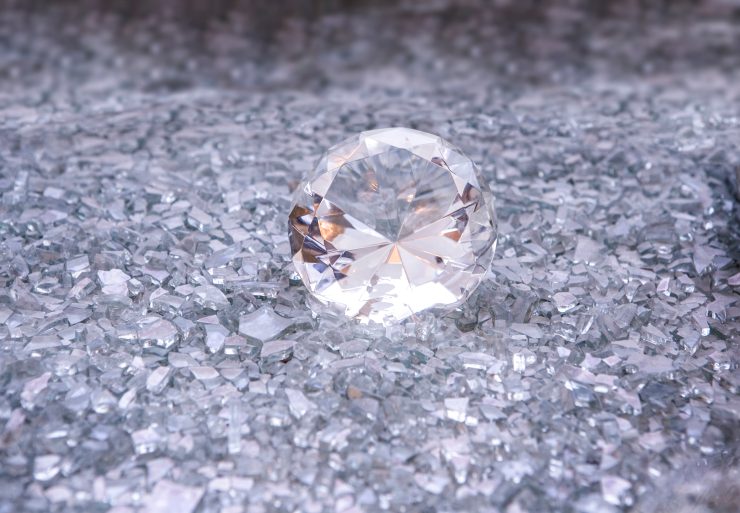Rising Popularity of Lab-Grown Diamonds in Modern Jewelry
Lab-grown diamonds have experienced a surge in popularity over the past decade, and this growth has been particularly prominent in the jewelry sector. A primary reason for this shift is the increasing consumer demand for ethically sourced and environmentally sustainable products. Unlike mined diamonds, lab-grown alternatives are created in controlled environments using high-pressure, high-temperature (HPHT) or chemical vapor deposition (CVD) methods. This minimizes the environmental degradation and human rights concerns often associated with traditional mining practices. As sustainability continues to shape buying decisions, more consumers are embracing lab-grown diamonds as a responsible and modern alternative. In addition, technological advancements have made it nearly impossible to distinguish between lab-created and mined diamonds without specialized equipment, which has helped bolster consumer confidence in their authenticity and quality. This ethical appeal, combined with affordability and indistinguishable visual quality, has positioned lab diamonds as a favorite among environmentally and socially conscious buyers, particularly Millennials and Gen Z consumers.

Engagement Rings and Custom Designs Dominate Market Preferences
One of the strongest trends in lab diamond jewelry is the dominance of engagement rings and customizable design options. Many couples now prefer lab-created diamonds for their engagement rings due to both price and ethical considerations. These diamonds are typically 30-40% less expensive than their mined counterparts, allowing buyers to either save money or afford a larger or higher-quality stone within the same budget. Customization has also become central to the appeal of lab-grown diamond jewelry. With lower base costs and growing consumer interest in unique designs, jewelers are offering increasingly diverse setting styles, stone shapes, and metal combinations. Popular styles include solitaire settings, halo designs, and vintage-inspired aesthetics. Oval and pear-shaped diamonds have gained traction alongside traditional round brilliant cuts, especially in bespoke and non-traditional engagement rings. The ability to tailor every aspect of the ring while maintaining ethical standards adds a personal and meaningful touch that resonates with today’s values-driven consumers.
Colorful Lab-Grown Diamonds Enter the Mainstream
Another trend transforming the lab diamond jewelry landscape is the growing popularity of colored lab-grown diamonds. While white diamonds remain the classic choice for many, colored diamonds—especially pink, blue, yellow, and even green—are increasingly being chosen for their vibrant appeal and rarity. Naturally occurring fancy colored diamonds are extremely rare and can be prohibitively expensive, but lab-created alternatives offer similar visual beauty at a much more accessible price point. The process used in growing colored lab diamonds involves either adjusting the growth environment to influence coloration or introducing trace elements such as boron (blue) or nitrogen (yellow). These techniques allow for consistent production of visually striking diamonds in a wide range of hues. Colored lab diamonds are especially popular in fashion-forward and avant-garde jewelry designs, where they provide bold statements and vivid accents. Their rising presence in both high-end and everyday jewelry collections illustrates a broader consumer appetite for personalization and uniqueness.
Vintage and Art Deco Styles Make a Strong Comeback
Lab diamond jewelry is increasingly being used in vintage-inspired designs, particularly those influenced by Art Deco, Edwardian, and Victorian aesthetics. These styles are marked by intricate detailing, geometric patterns, and elegant craftsmanship, offering a dramatic contrast to the minimalist trends of the 2010s. The resurgence of these historical styles speaks to a larger consumer desire for timelessness and nostalgia, with lab diamonds allowing these designs to be recreated affordably and ethically. Designers are incorporating lab diamonds into filigree rings, milgrain-edged bands, and multi-stone settings that pay homage to antique craftsmanship while using modern materials. This blend of the old and new is highly appealing to buyers who value both historical beauty and contemporary ethical standards. Furthermore, vintage designs pair exceptionally well with lab-created colored stones, further fueling their popularity. As people look for jewelry that tells a story or connects them to tradition, these vintage trends are likely to remain prominent in lab diamond collections for years to come.

Gender-Neutral and Inclusive Jewelry Gaining Ground
Inclusivity in jewelry design is becoming a core value, and lab diamond jewelry is playing a significant role in shaping gender-neutral offerings. Modern consumers are increasingly seeking designs that reflect diverse identities, moving away from binary and gendered styles. This has led to a rise in unisex rings, minimalist bracelets, and stud earrings that feature lab-grown diamonds in subtle, elegant settings. Jewelers are also innovating with mixed-metal designs, modular components, and customizable features that allow wearers to adapt their jewelry to their style without regard to traditional gender associations. In addition, marketing strategies have evolved to reflect this inclusivity, with many brands showcasing lab diamond jewelry on models of varying gender identities and expressions. This trend is driven not only by social change but also by the practical benefits of lab-grown diamonds—affordability and flexibility—making them ideal for broad consumer experimentation. The future of lab diamond jewelry appears to be inclusive, versatile, and self-expressive.
Lab Diamond Jewelry and the Rise of Sustainable Luxury
The concept of “sustainable luxury” is redefining what it means to own high-end jewelry, and lab diamond jewelry is at the forefront of this evolution. Traditionally, luxury items have been associated with exclusivity, rarity, and opulence, often without regard for ethical or environmental implications. However, as global awareness of climate change, ecological degradation, and fair labor practices has grown, consumers have begun to demand transparency and accountability from luxury brands. Lab-grown diamonds perfectly align with these values by providing a luxurious yet conscious alternative. They offer the same chemical and optical properties as mined diamonds, but without the associated carbon footprint, mining damage, or questionable labor practices. Many top-tier jewelry designers and luxury brands have embraced lab-grown diamonds in response to these changes, integrating them into high-end collections without sacrificing quality or prestige. As a result, sustainable luxury is no longer a niche—it’s a new standard, and lab diamond jewelry is central to that transformation.
Technological Advancements Drive Design Innovation
Rapid advances in lab diamond production technologies have not only improved quality and efficiency but also enabled more experimental and innovative jewelry designs. With better control over the growth process, manufacturers can now produce diamonds in a wider variety of sizes, shapes, and colors with greater consistency. This has expanded the creative possibilities for jewelry designers, allowing them to develop intricate and avant-garde pieces that would be cost-prohibitive or logistically challenging with mined diamonds. For example, stacking rings with unusually cut diamonds, pavé necklaces with multi-colored stones, or architectural cocktail rings have become more accessible. Furthermore, the predictability of lab diamond characteristics reduces the need for compromise during the design process, as designers are not constrained by the irregularities and sourcing limitations of natural diamonds. This synergy between technology and artistry is helping the jewelry industry redefine luxury aesthetics, combining innovation, ethics, and beauty in new and compelling ways.
Younger Generations Redefine Jewelry Ownership and Values
Millennials and Gen Z are significantly shaping the trends in lab diamond jewelry due to their distinct values, digital fluency, and purchasing behavior. These younger consumers prioritize authenticity, sustainability, and social responsibility over traditional status symbols. For them, owning a diamond is not about adhering to convention but about expressing personal style and values. Social media also plays a substantial role in influencing trends, as platforms like Instagram, Pinterest, and TikTok amplify unique lab diamond designs and ethical narratives to a global audience. Lab-grown diamonds are particularly well-suited to this demographic because they align with their budget consciousness and demand for transparency. The ability to choose a conflict-free, sustainable diamond that is just as beautiful as a mined one fits squarely into their worldview. In addition, digital-first lab diamond retailers have made it easier to compare options, design custom pieces online, and understand the origin of every stone, further empowering these generations to make informed, value-driven purchases.
Redefining Bridal and Anniversary Traditions
Another evolving trend in the lab diamond jewelry space is the reinterpretation of traditional bridal and anniversary jewelry. While diamond engagement rings have long symbolized love and commitment, modern couples are infusing these traditions with new meaning by choosing lab-grown diamonds. Many see this choice as a reflection of shared ethical values and a mutual commitment to sustainability. Furthermore, lab diamonds allow for more creativity in bridal sets, with couples often designing coordinating rings that blend traditional motifs with personalized touches. Similarly, anniversary bands featuring lab diamonds are gaining traction, as they provide an elegant yet responsible way to commemorate milestones. Stackable bands with various diamond shapes, multi-row pavé settings, and alternating colored stones are all popular choices in this category. As traditions become more inclusive and personalized, lab-grown diamonds are helping to support a new kind of storytelling in commemorative jewelry—one rooted in intention, responsibility, and individuality.
Price Accessibility Fuels Wider Market Penetration
Price remains one of the most compelling factors driving consumer adoption of lab diamond jewelry. Because lab-grown diamonds bypass the costs of mining, transport, and middlemen typically associated with natural stones, they are available at significantly lower price points—often 30% to 70% less than comparable mined diamonds. This pricing advantage opens up opportunities for consumers who might not otherwise consider diamond jewelry due to budget constraints. It also allows for the purchase of larger or higher-quality stones without compromising on financial priorities. As a result, lab diamond jewelry is increasingly popular not only for major life events like engagements or anniversaries but also for self-purchases, gifting, and everyday wear. Jewelers have responded by expanding their product lines to include lab diamonds in earrings, pendants, bracelets, and fashion rings across a wide range of styles and price categories. This democratization of diamond ownership is reshaping consumer expectations and making high-quality, meaningful jewelry more accessible than ever before.